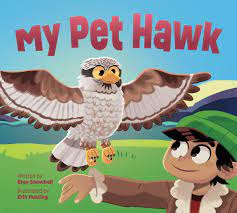My Pet Hawk

My Pet Hawk
Finally, I got close enough to see the baby hawks in their nest. They had down-like fur in beautiful shades of gold and brown. They just stared at me. They had probably never seen anything like me before.
There were three babies of different sizes. I chose the biggest one to be my pet. I thought it would be able to fly sooner. When I tried to pick it up, it started biting me. But eventually it stopped fighting and let me take it. Maybe it was in shock.
I held the hawk in my right arm and started climbing back up the cliff with my left. It seemed a lot faster going up than down, maybe because of my excitement. When I got to the top, I put the hawk in a soft spot as I wound up the rope.
When I went to pick up the hawk again, it faced me with its mouth wide open. It looked like it was going to bite me again. I nervously picked it up by its back and started walking. I felt very proud of myself for successfully completing my journey. I couldn’t stop smiling as I walked back.
I made my way back to where I had left my jacket. I put my jacket on and soon became so warm that I was drenched in sweat. My smile started to fade as I grew tired from my journey. I knew I still had a long way to go to get back.
I met up with the tourist and the guide again to go back across the river. The tourist saw that I was holding the hawk and said how beautiful it was. The guide looked annoyed that I had taken so long.
My Pet Hawk is an autobiographical story of one summer in the life of an Inuk boy who adopts a baby hawk as a pet. Even though it is nonfiction, the book reads as narrative. One day the boy sees a hawk catch a lemming and fly back to a cliff. He deduces that there is a nest there and is determined to find it for he “had always wanted a pet that flew.” What pet-less child hasn’t dream of finding and taking home an animal as his or her own pet?
Etua, the boy, lives in a summer cabin with his family in Kuujjuaq, Nunavut, from spring to fall. His family runs a business taking tourists fishing, and he trails along with the tourists the day after seeing the hawk. The tourist guide allows Etua to cross the river with a tourist, and Etua runs off towards the cliff. After a tiring hike, Etua rappels himself down the cliff after tying a rope around a rock. He captures the largest of the three hawk babies. Once back home, he creates a nest in a box with grass and feeds the hawk chick fish. After the chick vomits up the fish, he is faced with a problem: what do hawk chicks eat? Remembering the lemming the hawk caught, he goes out to catch lemmings which is harder than it would seem. When the young hawk swallows the whole lemming and looks at the boy for more, Etua realizes that keeping the chick fed will be challenging.
As the chick grows, it rides around on Etua’s forearm. Etua begins to teach the chick how to hunt lemming for itself. Etua’s tying a dead lemming to a rope and dragging it behind him with the hawk running after it is a humorous start. The chick catches on, and, after it learns to fly, it also learns how to catch its own lemmings and the boy is freed from this task. The boy experiences sadness as the hawk becomes more independent and stays away longer and longer. Soon it no longer returns, but the boy spots it once in awhile in the sky. The story ends when the boy leaves the summer home for the winter, and he never sees the hawk again.
The text is simple and easy to understand for the target audience. It is part of a Nunavut-developed leveled reading series and is at the grade 2 level. My Pet Hawk adds to the growing collection of stories written by indigenous authors. This book allows the reader a peek through the window into the Canadian Arctic landscapes and way of life. The story strongly engages the reader, for it tells a story most children can connect to.
The illustrations in My Pet Hawk are cartoon-like in appearance and give a breathtaking look at the Arctic landscape. The illustrations are beautifully drawn and include great details, especially of the hawk. The colours are bright and attractive. The book includes a warning before the story begins, one that encourages people not to take baby animals out of their nests and to call the local wildlife officer when finding an injured animal.
Karina Wiebenga is a Learning Support educator in Burnaby, British Columbia.
